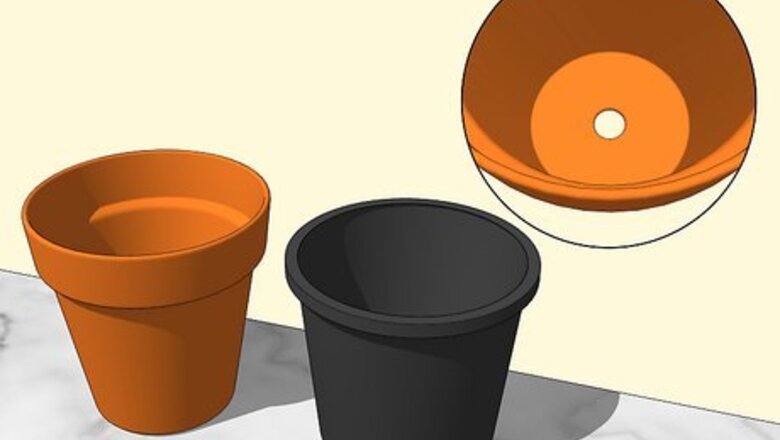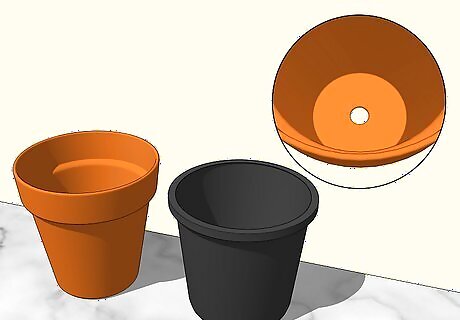
views
Preparation
Decide on a style of garden. When gardening indoors, there are two general styles of gardening: container gardening, and hydroponic gardening. Container gardening is just as it sounds - a series of planters/containers that use traditional gardening soil and methods to grow your plants. A hydroponic garden is a special type of indoor garden that uses fertilized water and a non-soil starter for your plants, arranged vertically. Each is a valuable option for different reasons: Container gardens are a good option for someone who may want to rearrange their plants or eventually move them outdoors. Container gardens can grow any type of plant, in any size. Hydroponic gardens are a good option for someone who is looking to produce a lot of plants in a small amount of space. Typically, hydroponic gardens are used for growing vegetables.
Choose the right space. Creating a successful indoor garden relies heavily on selecting a space indoors that will help your plants to grow. Choose an area that has lots of windows and sunlight; typically east and west facing windows are the best. When at all possible, place your garden (container or hydroponic) near a window to allow for more heat and sunlight. Avoid rooms that have cold temperatures (such as an attic or garage); cold can kill or slow the growth of your plants while heat is typically more universally welcomed by your plants. Avoid choosing an area near an air vent or fan, as these can dry out your plants and cause damage to them.
Properly control the environment. The biggest reason for planting an indoor garden is the ability to completely control the environment. While this requires more work, it also greatly increases the success of your plants when done properly. There are three general things you’ll be in charge of controlling: air temperature, water frequency, and soil condition. These will vary slightly depending on the system of garden that you are using and the plants you decide to grow, but there are a few helpful tools to make controlling the environment easier. Try soil heat mats. In general, most plants thrive in soil temperatures between 75–85 °F (24–29 °C). You probably don’t want to have your house heat on that high, especially in the winter. To remedy this, you can purchase electric mats made for heating pots from the bottom, regulating the temperature of the soil. Get a drip system. Watering regularly can be a difficult habit to master; rather than setting reminders for yourself daily, try getting a drip system. This works with a series of small tubes supplied to each plant, and a timer that turns the water on/off for a certain period each day. Choose a lighting system. Although windows let in a little sunlight, you’ll primarily be in charge of giving your plants light through artificial means. Fluorescent light tubes are typically considered the best choice because they are cost effective and give good results. Otherwise, you can buy a specialty heat-lamp for growing indoor plants.
Choose your plants. Just like a garden outside, there is a huge variety of plants you can grow indoors including vegetables, berries, herbs, flowers, and decorative greens. Before you head to the nursery and start picking out random attractive plants, you must determine which plants will work well in your garden. Some plants will flourish indoors while others will struggle. Some popular plants to grow indoors include: Vegetables such as lettuce, beans, peas, and mushrooms, and fruits like strawberries. Herbs: basil, bay, chives, oregano, parsley, rosemary, sage, tarragon, and thyme. Flowers: peace lily, African violet, marigold, begonia, cactus, and succulents.
Container Gardens

Choose your containers. Because you’re growing indoors, you have a wide variety of options for containers to plant in. You can go with traditional pots or containers from a garden supply store, or be unique and use old vases or plastic bottles. You don’t need a large container to start seeds, and if you’re transplanting a plant you’ll need a container twice the size of the root ball. Otherwise, look for a container that has holes in the bottom to allow for drainage, or simply drill holes into any container. Plastic containers retain moisture the best, but terra cotta pots are typically seen as the most attractive option. Try recycling old coffee cans or 1-liter plastic bottles to use. This way you’ll be green while gardening - a double bonus! You can line the bottom of your container with rocks for added drainage. If you use a wooden container, try to find one made of redwood or cedar, which are particularly rot resistant. Don’t use any container that has been treated with chemicals, as this could kill your plant.
Create your potting mix. Unfortunately, you can’t just grab a bunch of soil from your garden and use it for planting your containers. Soil from outside often contains diseases and insects that can kill off your plant over time, and is rarely the proper balance of sand/clay for the ideal porous-ness. While you can purchase pre-made potting mix, you’ll save more money and guarantee the quality of your mix by creating your own. To make your own potting mix, you’ll need 1 part coir peat, 1 part vermiculite, and 2 parts compost. These are all available at your local gardening center. Soak the coir peat brick to rehydrate it; typically these come with directions, so follow the attached instructions on soaking. Mix your coir peat and vermiculite together until well mixed, and then add in the compost. If you’re able, worm castings are an excellent addition to your soil mix; add ½-1 cup of worm castings to your mix prior to planting your containers.
Set up your garden system. If you’re planting a large indoor garden, you’ll need to create a shelving system for your plants. Otherwise, use the aforementioned tips to select a space for your container garden. You’ll also have to set up your control factors: your light, water system, and temperature controls. If you’re using a shelving system, it should be easy to hang fluorescent lights and your drip system to the shelves. Otherwise, work your space until you have all the components adjusted. Heat mats should be placed underneath the locations of your containers. You can purchase timers for your lights, heat mats, and drip systems so that they are only on during certain times of the day. Keep in mind that certain plants require different amounts of light, and group them appropriately. For example, put all the light-loving plants near each other and the shade-loving plants near each other, and adjust the light output accordingly.
Maintain your plants. After planting your garden, you’ll need to upkeep it in order to be successful. Make sure that your plants are getting regular amounts of sunlight and water, and that the soil temperature does not drop below 70 °F (21 °C). When your plants become too large, you’ll need to transplant them into larger pots or split them into more plants, either to keep or to give away. If you notice any plants with brown spots, that are wilting, or are clearly dying, remove them from the rest in case they carry a disease or pest that might spread. You can incorporate compost or fertilizer into the containers every few months to help supply the plants with nutrients. If you have a drip irrigation system, you can dose a liquid fertilizer in the system every few weeks to keep plants going strong. You can set your pots in trays of rocks so that the water that drains out will provide humidity for them as they grow.
Hydroponic Gardens
Choose a hydroponic system. There are many different ways to set up a hydroponic garden, but they all follow the same theme: a water tank is located on the bottom, and stacks of shelves/plants are placed on top. The fertilized water from the tank is fed to the plants using a pump system, and the water filters down through the plants and excess is drained back into the original water tank. A few variations of this system include: Creating a small-scale hydroponics system. You don’t need a massive shelving unit and lots of supplies to create a basic system. Instead, you can use cut-off plastic bottles and a sunlit window. Consider making a window system for a tight space. Using one large container instead of many small ones. There are so many variations of hydroponic systems, and one of them includes using a large tub to produce a lot of the same crop, instead of using multiple small containers.
Choose your location. Just like with a container garden, a hydroponic garden will thrive with the most available sunlight. Choose a space near a window; in fact, if you’re using a small garden the window may be the only necessary source of light. Otherwise, you’ll need to find a location with a lot of vertical space for the stacking that is necessary for the system. Try using a shelving unit or organizational bookshelf for your hydroponics system. Don’t place the shelves directly over or under an air vent/duct. When possible, put your hydroponics system on hard floors rather than carpet to avoid mold and mildew growing.
Prepare your containers. As with a container garden, virtually any container is appropriate for a hydroponics system so long as it isn’t chemically treated and allows for drainage through the bottom. You’ll need to drill holes into a container that does not have them so that the water can filter out at the bottom. Instead of using potting soil for your containers, though, you’ll be filling your pots with a hydroponic substrate. Then, plant your seeds as per usual and water them heavily to help reduce transplant shock. Proper substrates for hydroponics include expanded clay, lava rocks, coco coir, and peat moss. Consider the speed of your pump when deciding how many holes to drill. You will need to allow the container to fill with water while the pump is running, and drain in between pump cycles. Install an overflow drain toward the top of your container to avoid flooding.
Set up your system. If you purchased a commercial hydroponics system, you’ll need to follow the package directions for setting it up. If you’re making your own homemade system, you can follow these loose directions for setting up. Put your water tank on the bottom shelf, elevated at least a few inches above the floor. Then, place your plant containers on the shelves above the tank; the container closest to the tank should be nearly covering it completely - there shouldn’t be much distance from the top of the tank to the bottom of the container. Set up your water pump system to deliver water to the plants on the shelves above. Your fluorescent lights should be hung directly above the plants. You can purchase a special timer to control the water pump so that it runs at specific times. Set your pump on a timer that runs 15 minutes for every hour. This allows the plants to drain so they can get oxygen. Talk to a local hydroponics expert at a nursery for specific advice to your system.
Maintain your system. Over time, you’ll need to make sure that your hydroponics system is in good condition so that it keeps running smoothly. Test your water for nutrients weekly, and add nutrients as necessary. Occasionally, you will need to drain all of the water in your hydroponic system and replace it.




















Comments
0 comment